Image Round-Up: Planetary Oppositions of 2018
By: Brian VentrudoDiscuss this article in the forums
September 15, 2018It's been a great year for planetary observers and imagers! One after another, the three bright major planets Jupiter, Saturn, and Mars reached opposition from early May to late July 2018. Planetary imagers have been busy this summer collecting data and processing some fantastic images of these three fascinating worlds. Here's a collection of recent images collected by amateur astronomers from around the world.
Jupiter
Jupiter reached opposition on May 9, 2018 in the constellation Libra. The planet reached a maximum apparent size of 45" and a maximum brightness of -2.5. Northern observers had a challenge this year as the planet was some 15 degrees south of the celestial equator, but many imagers, including those featured below, still captured some great shots of the biggest of planets.
The next opposition of Jupiter is on June 10, 2019.
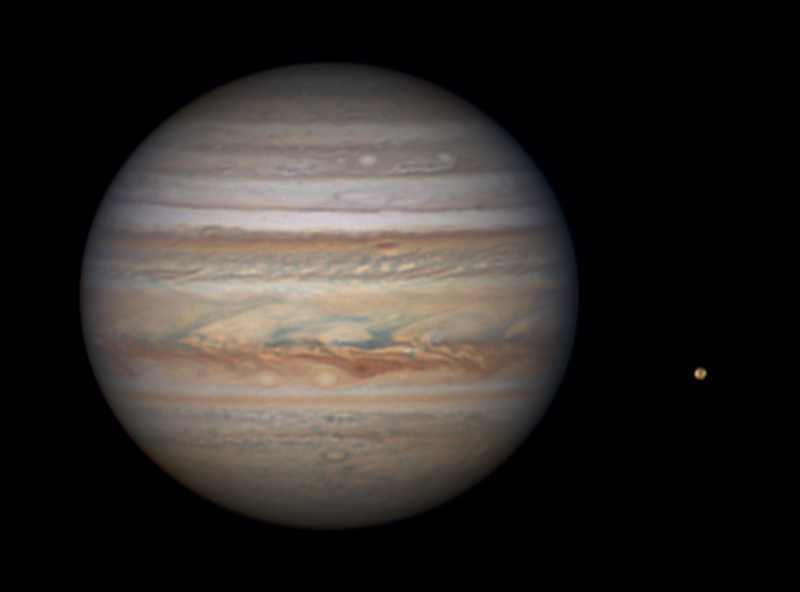 Image 1 – Ivan Gong of Zhuhai, China captured this image of Jupiter and Io from his balcony on May 27, 2018. He used a Sky-Watcher 12" Dobsonian, ZWO ASI290MM camera, Tele Vue 3x barlow, and Optolong LRGB filters. See more of Ivan's work at this link: https://www.astrobin.com/users/ivan11223/
Image 1 – Ivan Gong of Zhuhai, China captured this image of Jupiter and Io from his balcony on May 27, 2018. He used a Sky-Watcher 12" Dobsonian, ZWO ASI290MM camera, Tele Vue 3x barlow, and Optolong LRGB filters. See more of Ivan's work at this link: https://www.astrobin.com/users/ivan11223/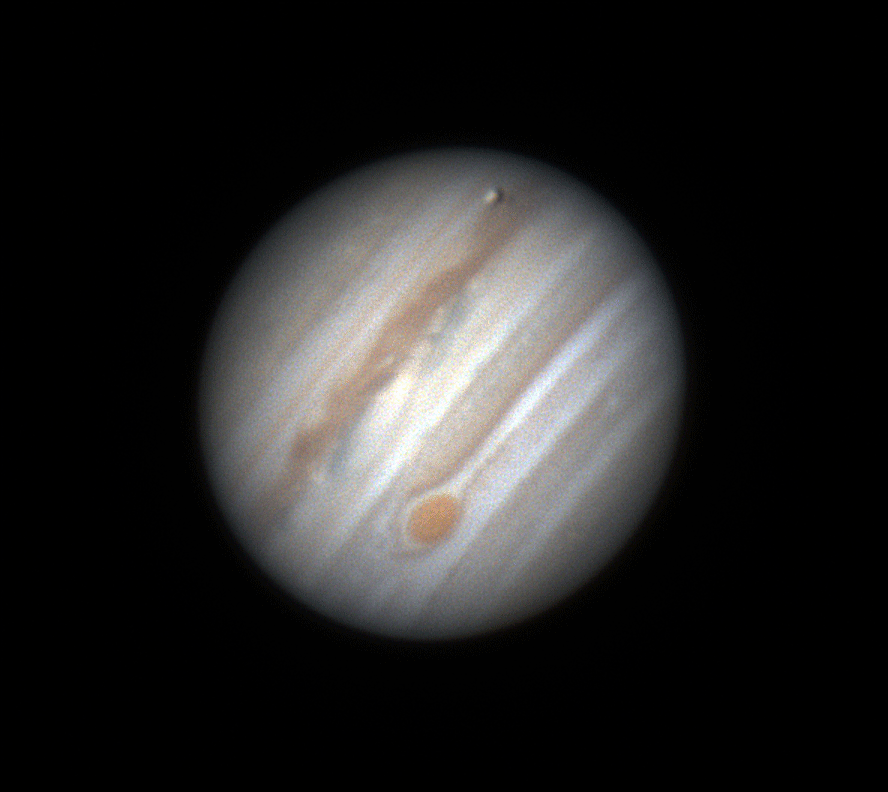 Image 2 – Nikita Misiura captured this image/GIF of Jupiter and Io on May 8, 2018 from Houston, TX. He used a Meade LX200 10" f/10 telescope, ZWO ASI224MC telescope, and a 2x barlow. See more of Nikita's work at this link: https://www.astrobin.com/users/nekitmm/
Image 2 – Nikita Misiura captured this image/GIF of Jupiter and Io on May 8, 2018 from Houston, TX. He used a Meade LX200 10" f/10 telescope, ZWO ASI224MC telescope, and a 2x barlow. See more of Nikita's work at this link: https://www.astrobin.com/users/nekitmm/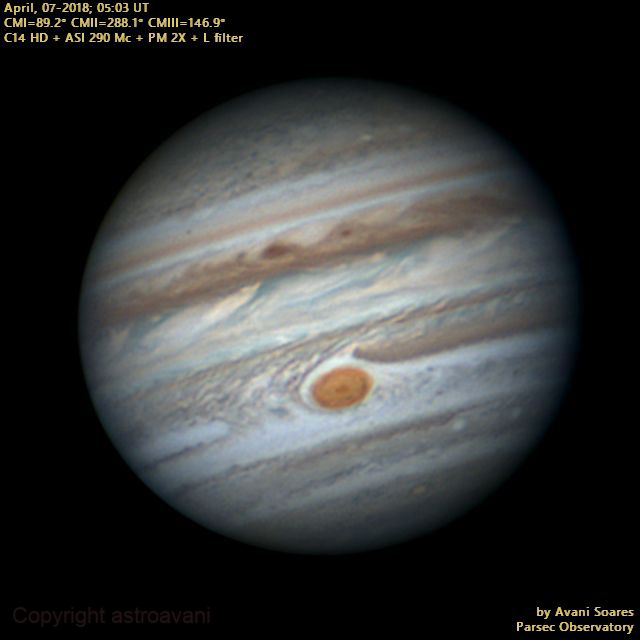 Image 3 – Avani Soares captured this image of Jupiter about a month before opposition on April 7, 2018 with a 14" CelestronEdgeHD, a ZWO ASI290MC camera, and a Tele Vue 2.5x Powermate. Avani, who observes from his Parsec Observatory in Canoas, Brazil, shares some of his work on the AstronomyConnect forums. You can see more of his work at this link: https://www.astrobin.com/users/astroavani/
Image 3 – Avani Soares captured this image of Jupiter about a month before opposition on April 7, 2018 with a 14" CelestronEdgeHD, a ZWO ASI290MC camera, and a Tele Vue 2.5x Powermate. Avani, who observes from his Parsec Observatory in Canoas, Brazil, shares some of his work on the AstronomyConnect forums. You can see more of his work at this link: https://www.astrobin.com/users/astroavani/Saturn
Saturn reached opposition on June 27, 2018 in the constellation Sagittarius. The planet reached a maximum apparent equatorial size of 18.4" and a maximum brightness of 0.0. As with Jupiter, northern observers had a challenge this year as the planet was about 22 degrees south of the celestial equator. The rings were tilted dramatically this year at an angle of about 25 degrees which made this beautiful planet exceptionally photogenic.
The next opposition of Saturn is on July 9, 2019.
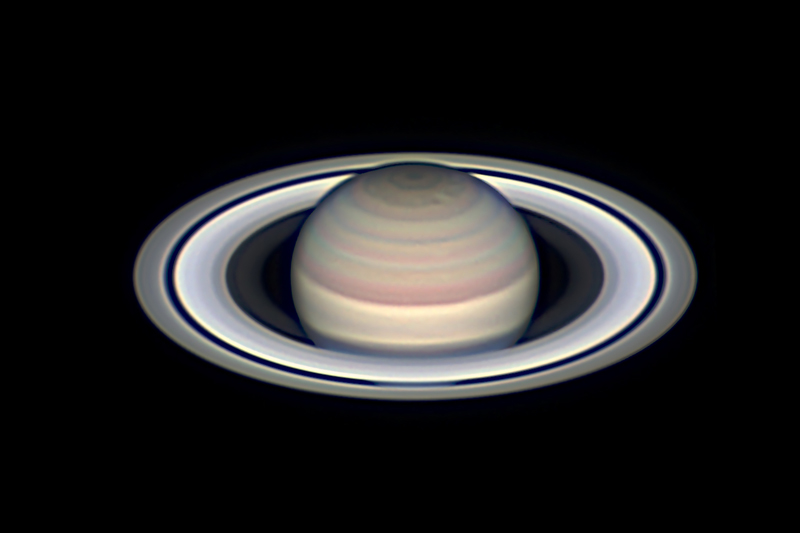 Image 4 – Niall MacNeill took advantage of his location in Wattle Flat, New South Wales, Australia to capture this image showing extraordinary detail and structure in the polar and temperate regions of Saturn. Imaged with a Celestron 14" EdgeHD telescope, a ZWO ASI174MM camera, a Tele Vue 2.5x Powermate, and a ZWO LRGB 1.25" filter set. Image captured on July 5, 2018, about three weeks before opposition. See more of Niall's work at this link: https://www.astrobin.com/users/macnenia/
Image 4 – Niall MacNeill took advantage of his location in Wattle Flat, New South Wales, Australia to capture this image showing extraordinary detail and structure in the polar and temperate regions of Saturn. Imaged with a Celestron 14" EdgeHD telescope, a ZWO ASI174MM camera, a Tele Vue 2.5x Powermate, and a ZWO LRGB 1.25" filter set. Image captured on July 5, 2018, about three weeks before opposition. See more of Niall's work at this link: https://www.astrobin.com/users/macnenia/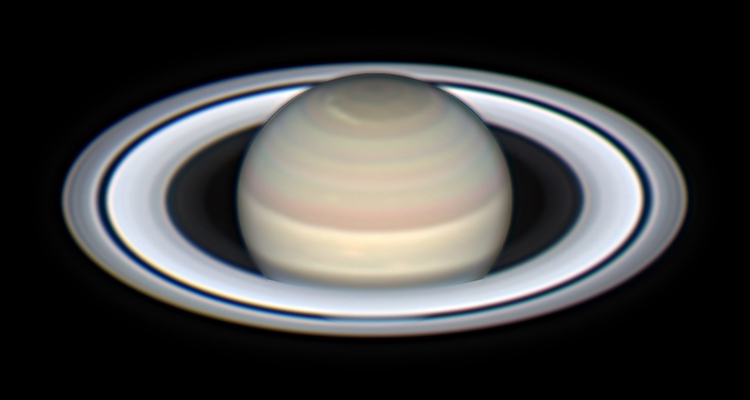 Image 5 – Using a 12" Sky-Watcher BKP300 12" Newtonian reflector, Michael Wong captured this image of Saturn on June 21, 2018. His location in New South Wales, Australia, where the planet was nearly overhead, helped Michael capture an amazing level of detail. He used a ZWO ASI290MM camera and a Tele Vue 4x Powermate. See more of Michael's work here: https://www.astrobin.com/users/lgwong/
Image 5 – Using a 12" Sky-Watcher BKP300 12" Newtonian reflector, Michael Wong captured this image of Saturn on June 21, 2018. His location in New South Wales, Australia, where the planet was nearly overhead, helped Michael capture an amazing level of detail. He used a ZWO ASI290MM camera and a Tele Vue 4x Powermate. See more of Michael's work here: https://www.astrobin.com/users/lgwong/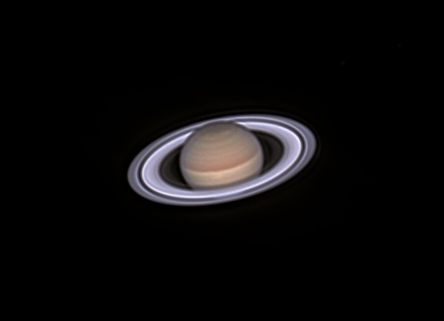 Image 6 – You don't always need a big telescope to capture a great image of a planet. Darren Mach put together this image of Saturn with a Celestron 6SE telescope, ASI290MC camera, and a Tele Vue 2.5x Powermate. The image was captured on June 29, 2018, near enough to opposition where the brightness of the rings may have been enhanced by the Seeliger Effect. See more of Darren’s work at this link: https://www.astrobin.com/users/DMach/
Image 6 – You don't always need a big telescope to capture a great image of a planet. Darren Mach put together this image of Saturn with a Celestron 6SE telescope, ASI290MC camera, and a Tele Vue 2.5x Powermate. The image was captured on June 29, 2018, near enough to opposition where the brightness of the rings may have been enhanced by the Seeliger Effect. See more of Darren’s work at this link: https://www.astrobin.com/users/DMach/Mars
Mars reached opposition on July 27, 2018 in the constellation Capricorn. This was the best Martian opposition in 15 years.The planet reached a maximum apparent equatorial size of 24.3" and a maximum brightness of -2.8. As with Jupiter and Saturn, northern observers had a challenge this year as the planet was about 25 degrees south of the celestial equator, almost as far south as it ever gets. To make matters worse, a planet-wide dust storm obscured many features in the days leading up to the opposition. But patience and good equipment helped serious imagers get some great shots of Mars this year.
The next opposition of Mars is on October 13, 2020.
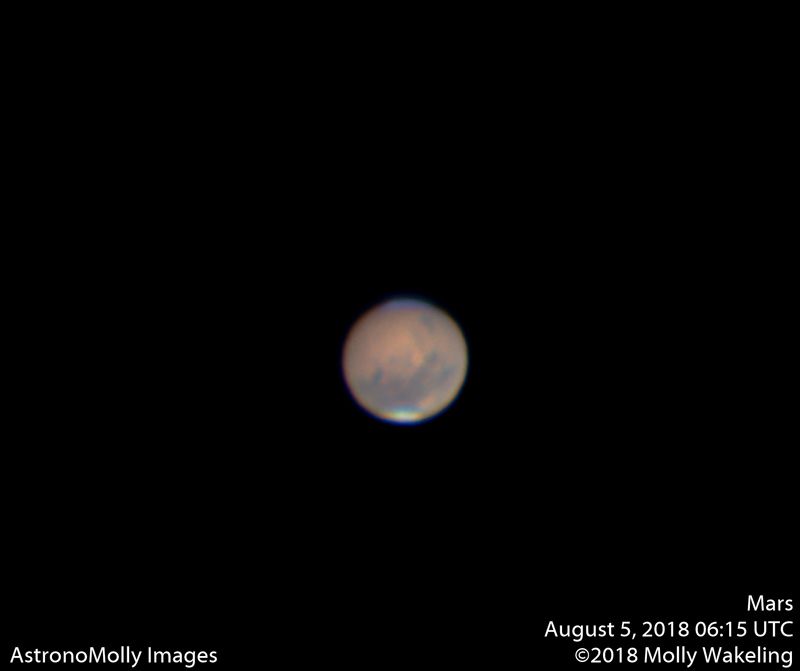 Image 7 – U.S.-based observer Molly Wakeling captured this image of Mars as the dust storms began to fade on August 5, 2018. She used a CelestronNexStar 8SE telescope, a ZWO ASI1600MM-Pro camera, and an Astronomik color filter set. See more of Molly's work at her blog: http://astronomollylog.blogspot.com/ or her AstroBin page: https://www.astrobin.com/users/mollycule/
Image 7 – U.S.-based observer Molly Wakeling captured this image of Mars as the dust storms began to fade on August 5, 2018. She used a CelestronNexStar 8SE telescope, a ZWO ASI1600MM-Pro camera, and an Astronomik color filter set. See more of Molly's work at her blog: http://astronomollylog.blogspot.com/ or her AstroBin page: https://www.astrobin.com/users/mollycule/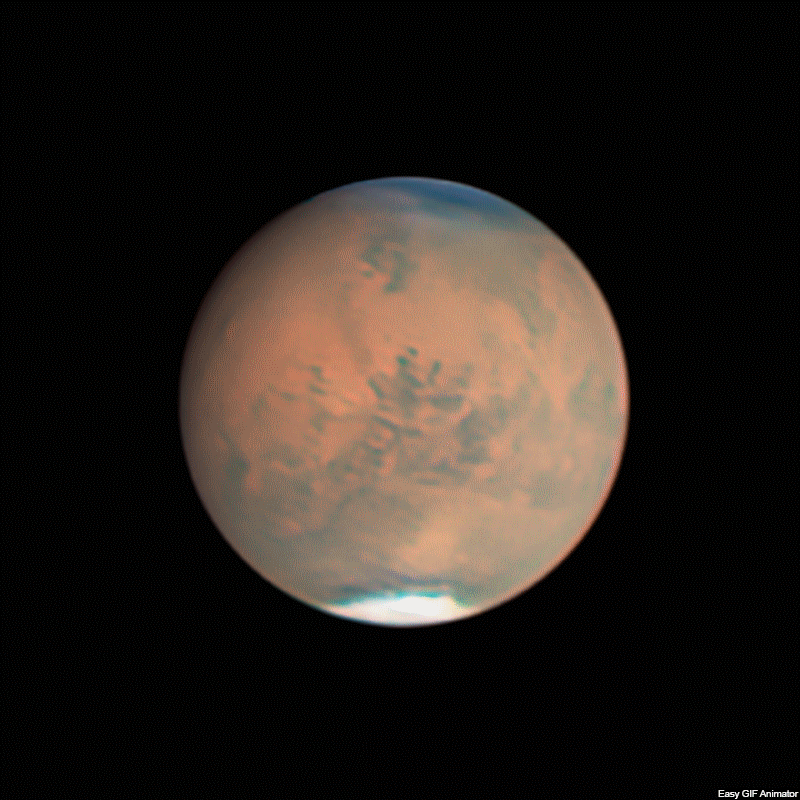 Image 8 – A GIF of Mars by Niall MacNeill of Wattle Flat, New South Wales, Australia showing the planet rotating over 2.5 hours. Note the appearance of the giant shield volcanoes at the upper left in the last few frames of the GIF. Imaged with a Celestron 14" EdgeHD telescope, a ZWO ASI174MM camera, a Tele Vue 2.5x Powermate, and a ZWO LRGB 1.25" filter set. Image captured on August 17, 2018, about three weeks after opposition. See more of Niall's work at this link: https://www.astrobin.com/users/macnenia/
Image 8 – A GIF of Mars by Niall MacNeill of Wattle Flat, New South Wales, Australia showing the planet rotating over 2.5 hours. Note the appearance of the giant shield volcanoes at the upper left in the last few frames of the GIF. Imaged with a Celestron 14" EdgeHD telescope, a ZWO ASI174MM camera, a Tele Vue 2.5x Powermate, and a ZWO LRGB 1.25" filter set. Image captured on August 17, 2018, about three weeks after opposition. See more of Niall's work at this link: https://www.astrobin.com/users/macnenia/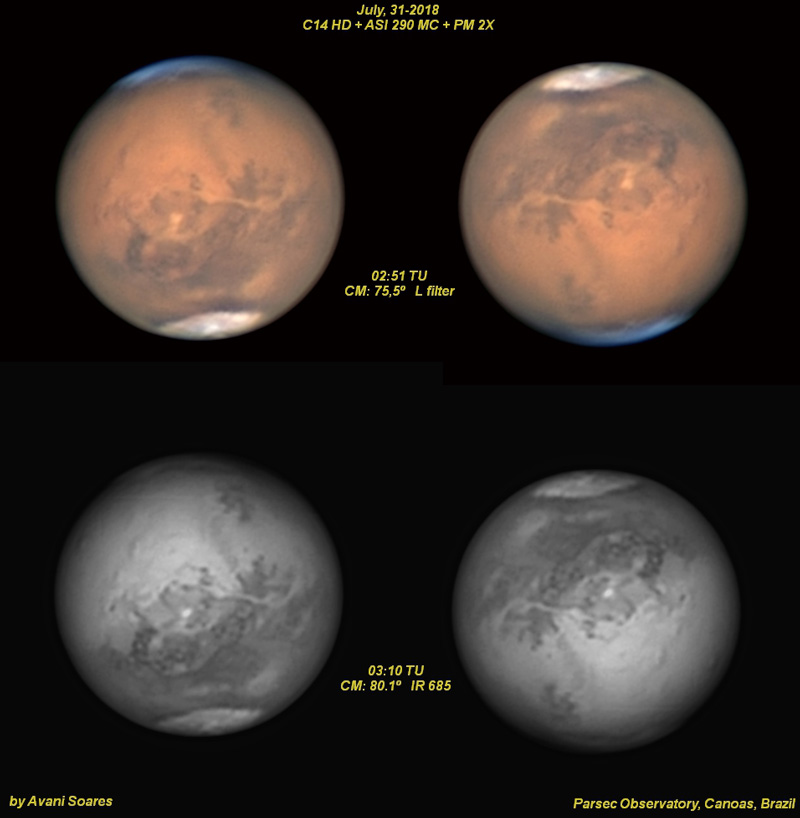 Image 9 – Images of Mars in visual and IR by Avani Soares captured on July 31, 2018 with a 14" Celestron EdgeHD, a ZWO ASI290MC camera, and a Tele Vue 2.5x Powermate from his Parsec Observatory in Canoas, Brazil. You can see more of his work at this link: https://www.astrobin.com/users/astroavani/
Image 9 – Images of Mars in visual and IR by Avani Soares captured on July 31, 2018 with a 14" Celestron EdgeHD, a ZWO ASI290MC camera, and a Tele Vue 2.5x Powermate from his Parsec Observatory in Canoas, Brazil. You can see more of his work at this link: https://www.astrobin.com/users/astroavani/ About the Author
About the Author
Brian Ventrudo is a writer, scientist, and astronomy educator. He received his first telescope at the age of 5 and completed his first university course in astronomy at the age of 12, eventually receiving a master's degree in the subject. He also holds a Ph.D. in engineering physics from McMaster University. During a twenty-year scientific career, he developed laser systems to detect molecules found in interstellar space and planetary atmospheres, and leveraged his expertise to create laser technology for optical communications networks. Since 2008, Brian has taught astronomy to tens of thousands of stargazers through his websites OneMinuteAstronomer.com and CosmicPursuits.com.
***
This article is © AstronomyConnect 2018. All rights reserved.
Please login or register to watch, comment, or like this article.Dave In Vermont likes this.
-
Final Announcement: We're Saying Goodbye to AstronomyConnect. Read Our Closing Notice.
Dismiss Notice
New Cookie Policy
On May 24, 2018, we published revised versions of our Terms and Rules and Cookie Policy. Your use of AstronomyConnect.com’s services is subject to these revised terms.

